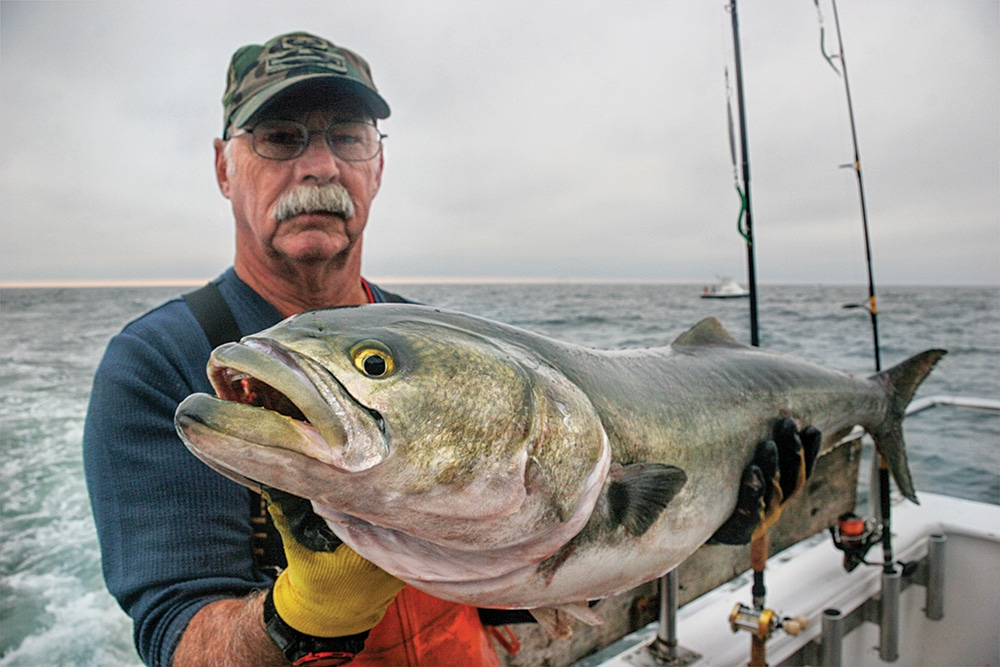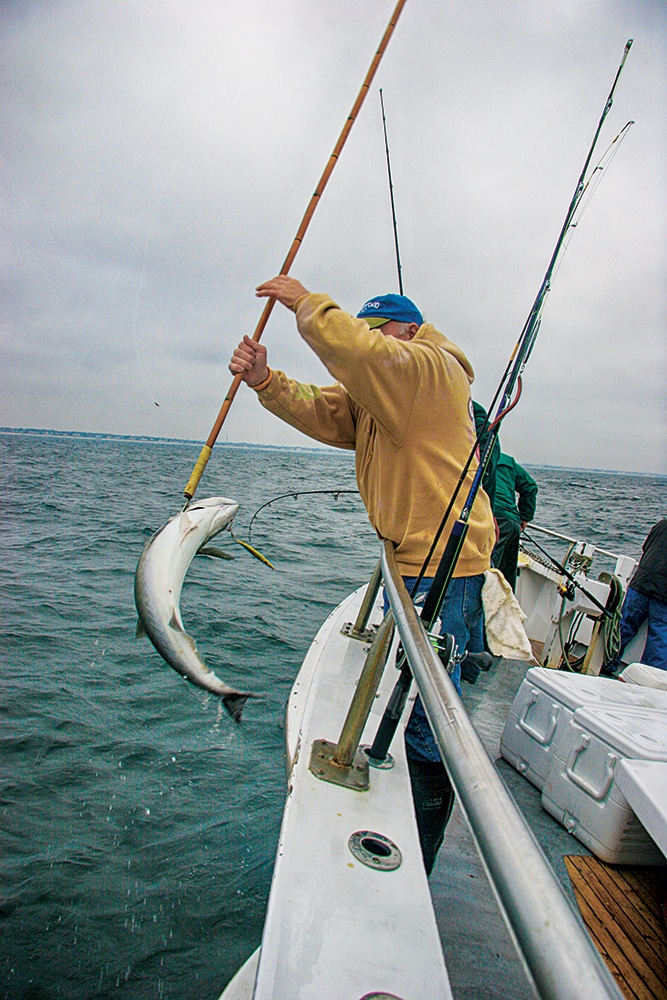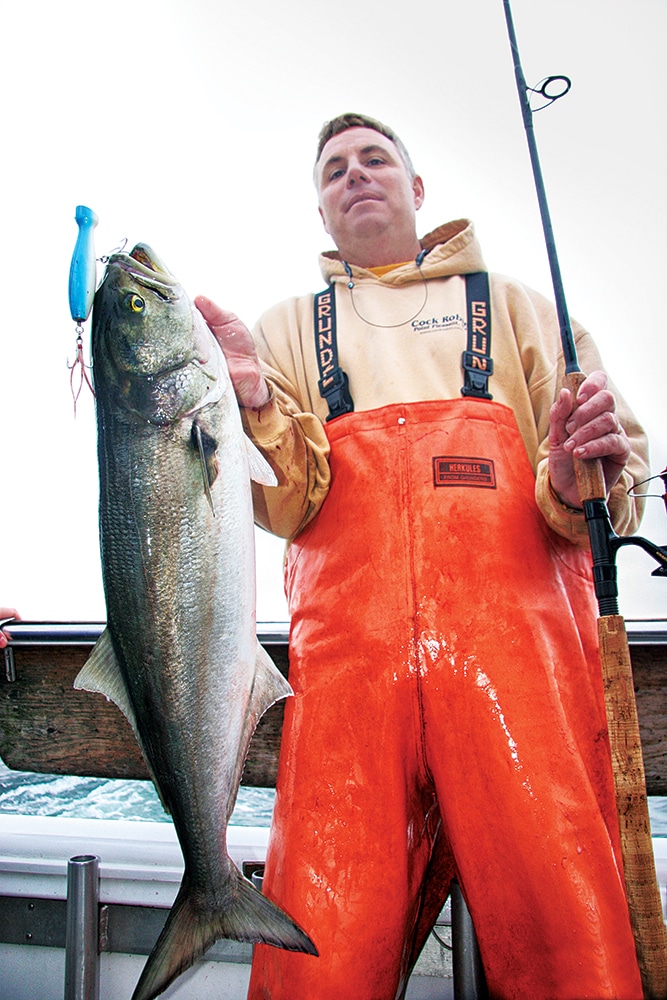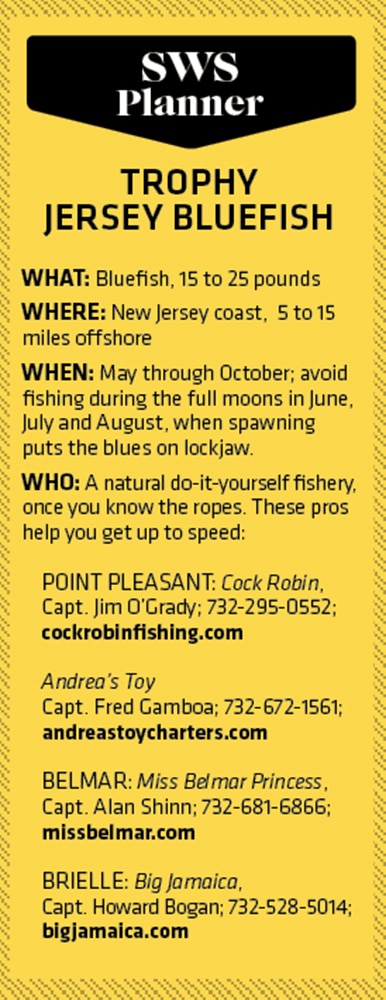You know you are not dealing with an average bluefish when you can fit a volleyball in its mouth. What you have before you then is one of the oversize specimens that New Jersey anglers often call gators or gorillas. We are talking 15- to 25-pounders, fish with the power and the chompers to easily take a finger, or worse, if you’re not careful. Those are the slammer blues that terrorize Garden State waters from late spring to early fall.
**Understand **the Monsters****
Bluefish exceeding 15 pounds are voracious feeders that prey on just about anything that swims, including younger members of their own species. This cannibalistic tendency is why they travel in schools with other blues of similar size. “Gator bluefish are segregated to a certain degree,” says Jim O’Grady, captain of Cock Robin. “If you’re catching smaller bluefish and then pull in a gator, you’ll notice the small ones clear out.”
Although the slammers might show up inshore in the surf, they’re most often 5 to 15 miles offshore. “A depth of 100 to 120 feet around Mud Hole seems to be the sweet spot,” explains Capt. Freddy Gamboa of Andrea’s Toy. “I think those larger fish hang on the edge of Mud Hole to take advantage of the upwelling, but we’ll even mark them down to 200 feet.”
Big blues also gravitate toward deepwater wrecks. “We always find the big dogs on the high-profile wrecks off Shark River reef, about 15 miles out. If you cut open their bellies and ling or bergall spill out, that means the bluefish are patrolling the bottom around the wreck, gobbling up whatever moves,” says Gamboa.
Gamboa also finds the fish while targeting larger pelagics. “Usually when we tangle with 15- to 20-pound blues, we are mako shark fishing 30 to 50 miles offshore. Those monster bluefish have mouths big enough to swallow a whole mackerel in one gulp, and a lot of times, they torture us by repeatedly hooking themselves on our shark baits.”
Steady Chunking
Bluefish follow a bunker slick like a lion going in for the kill, so a good chum line with steady deployment of bunker chunks draws them in day or night. In this case, bigger is not necessarily better. “Normally you’d think big baits get the big fish, but those gators happily gorge on 1-inch chunks of bait. It’s like they’re filling up by eating thousands of peanuts,” says O’Grady. “That said, you can fool them with three or four 1-inch pieces lanced on the hook.” But there comes a time to go bigger. “When smaller fish are gobbling up the tiny chunk baits, I’ll opt to cut the back of a bunker lengthwise into a 5-inch pennant shape, then hook it through the nontapered end, and free-line it back into the slick.”
Normally a weightless line offers the most natural presentation, but in a strong-running current or when the fish are holding deeper, a small split shot or a ½- to 1-ounce egg sinker above the barrel swivel gets the bait down into the chum line. Remember to keep your reel in free-spool with slack line so the bait drifts naturally.
It requires a little finesse to sink the hook when chunking, particularly with a revolving-spool reel. “When you see the line spooling off, keep a thumb on the spool, give it a slow count to three, and then use your other hand to engage the drag. Do not take your thumb off that spool to engage the reel: You’ll backlash horribly and snap off the fish,” says O’Grady.
Bring Jigs into Play
Both captains agree that chumming and fishing with bait chunks is not always the most productive strategy. “The presence of sand eels usually means we’ll switch to metal jigs before we chunk or live-line,” says Gamboa. “You want to work the entire water column, dropping the jig to the bottom and reeling up to the surface.”
The quicker the retrieve, the better, according to O’Grady. “Reel the jig to the surface as fast as you can. Those gators want the chase. Don’t bother swinging a jig up and down. Bluefish will just laugh at you.” And when you get throttled on a jig, note how many cranks off the bottom you were. Bluefish stage at certain depths and hang there for awhile, so you are bound to get another hit if you repeat that process on the next drop.
Cut to the chase and opt for thin jigs, as their wider-profile counterparts take longer to wobble downward. Be aware that even bluefish get picky sometimes, and hit only naked jigs or those with a certain-color tail. So come prepared with an array of colors and sizes, but don’t use shiny new lures for rampaging blues if you don’t have to. The scrappiest metal jigs you have in your tackle box work just as well.
Time for Live Bait
Especially during fall, when the big blues corral bunkers and sand eels close to shore, it’s time for live bait. Snag-and-drop tactics –– ripping a weighted treble hook through a baitfish school to snag a livie and then drop it to the bottom –– provides a quick and easy live-bait presentation. “I’ll generally bring the bunker back into the boat, rehook it through the anal vent with a 5/0 Octopus hook, and send it back down,” says Gamboa. “The bunker swims downward as the blues come up to the surface to inhale it.” Gamboa also hooks the bait through the anal vent when bluefish start chomping off the tails of the baitfish.
Surface Action
When the big blues are really busting up bait schools, topwater poppers make those gorillas go bananas. Casting around the outskirts of a bunker school under attack and ripping the popper across the surface results in explosive strikes. A reminder: Swap out the trebles on topwater lures for J-hooks, or your bluefish outing will end with a trip to the emergency room.
At the right time of year, tangling with bruiser-size bluefish is standard fare in New Jersey, where the state record tipped the scale at a whopping 27 pounds, 1 ounce — just 4 pounds shy of the IGFA all-tackle world record. So prepare yourself for battle, and come test your mettle with a true sea monster this fall.















